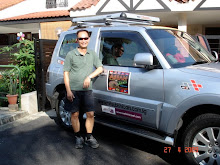 1. Overall the self drive road trip entailed the following:
1. Overall the self drive road trip entailed the following:(1) Over 30 days, from 18 May to 16 June 2010.
(2) Traveled a total of 6 812 miles, or 10 963 km, driving only in the day, alternating between Weiping and I.
(3) Visited or passed through 10 states - Wisconsin, Minnesota, South Dakota, Wyoming, Montana, Utah, Arizona, Colorado, Nebraska, and Iowa; and 11 states if we include New Mexico where we were at the Four Corners National Monument site for 15 mins.
(4) Visited 7 national parks - Glacier, Yellowstone, Grand Teton, Arches, Bryce, Zion, and Grand Canyon; 2 national monuments - Mt Rushmore and Four Corners; and 2 state parks - Custer and Dead Horse Point State Parks.
2. Car used was Weiping's 2 year old Hyundai Elantra. As roads traveled were generally very good, a normal saloon car like this was good enough. However, some roads in the national parks are unsealed, for instance in Glacier, Canyonland and Arches, which we would have loved to explore if we had a 4 by 4. Overall, not a serious handicap, but a good to have. And of course, we are talking about summer.
3. What if the car breakdowns during the trip? Weiping's car insurance provides for some breakdown service. We didn't have to use it, luckily. At worst, we recognised that we may have to scramble a little to get the service of local workshop.
4. We should have considered weather changes more seriously. As we were starting out in mid-May, going into June, we assumed it was summer. As it turned out, it was still cold, and raining, in Glacier; and we had unexpected snow fall in Yellowstone. Rather than starting in the North, it could have been better starting in the South and traveling Northwards to Glacier instead. We cannot be certain about weather, but it probably would give us a better chance for better weather.
5. The US National Parks' Annual Pass, at US$80 per car (passengers included), is great value. With entrance fee at mostly US$25 per car at the National Parks, we had saved quite a bit, in addition to the use of the pass for the remaining part of the year.
6. With a little more time, and if we were not parks fatigue by then, there are other interesting parks that we could have included. For instance, there's Dinosaur National Monument at the border of Utah and Colorado which would have been a small detour and would have been interesting based on what we read. Also, one fellow traveler told us we must go and see the Crater Lake National Park in Oregon which was too much of a change to the original plan. We used "Thousand places must see before you die" and later Fodor's Complete Guide to The National Parks of the West for planning the trip. With more research and more time for the trip, a different itinerary could have been conceived.
7. Less the cost of the car, we spent a total of US$5 800 which included cost of accommodation, food, petrol, tour tickets. That worked out to be about US$200 a day, for 3 persons, or about S$100 per person per day; about the cost per person per day for the 2 earlier ASEAN trips.
8. Average cost for accommodation was about US$100 a day (US$3226/30 days). Typically, we booked into rooms with 2 beds, preferably with a kitchenette, and we cooked dinners whenever time permitted. Our favorite is Candlewood Suite. It's clean and fairly spacious and the rooms come with free laundry and Wifi and with a kitchenette with good inventory of cooking utensils.
9. During the trip, we saw many Americans traveling in camper-vans (or RV), carrying their bicycles and/or kayaks, and sometime towing their cars, visiting the parks. RV parks are quite generously provided for in the parks but they require prior booking. This is one way of traveling - could save on accommodation cost, roughing it out a little more, but could be more interesting and flexible. I can imagine what's like waking up to the stunning scenery in the parks. Alternative is to stay in the lodges in the parks. They are beautifully designed, steep in history, but prices are not unexpectedly on the high side though not unreasonable taking into account their excellent locations. I understand prices charged in the parks are regulated by the US National Parks. But, given their popularity, booking ahead is essential, but this means tying down the travel plan. In the end, it comes down to individual preferences.
10. Overall, a trip like this is quite doable for most people. All it takes is to have an outline plan and say go, and be prepared to accept some surprises from time to time.
Photo Credit: Weiping, taken without my knowledge, circulated to my family without my permission with caption, Story of Papa's life.































































